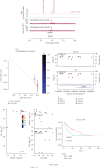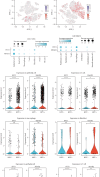Integrative Analysis of Shared Pathogenic Genes and Potential Mechanisms in Gardnerella vaginalis and Persistent HPV16 Infection
- PMID: 40510586
- PMCID: PMC12162162
- DOI: 10.1155/mi/2582989
Integrative Analysis of Shared Pathogenic Genes and Potential Mechanisms in Gardnerella vaginalis and Persistent HPV16 Infection
Abstract
Bacterial vaginosis, often accompanied by Gardnerella vaginalis (GV) overgrowth, is associated with persistent high-risk human papillomavirus (HR-HPV) infection, particularly HPV16. This study integrated transcriptomic data from in vitro GV infection experiments and a GEO dataset (GSE75132) of HPV16 persistence to elucidate shared pathogenic mechanisms. Differential expression analysis identified 4115 genes modulated by GV infection and 861 by HPV16 persistence, with 74 common differentially expressed genes (DEGs) displaying consistent trends. Enrichment analyses revealed that these DEGs participate in metabolic pathways, immune defense, host-pathogen interactions, and carcinogenesis. Protein-protein interaction networks and Random Forest (RF) feature selection pinpointed radical S-adenosyl methionine domain containing 2 (RSAD2) and Interferon-induced protein with tetratricopeptide repeats 1 (IFIT1) as central hub genes. Upstream transcription analysis identified the homer_AGTTTCAGTTTC_ISRE motif and established a ceRNA network involving hsa-miR-654-5p, IFIT1/RSAD2, and lncRNAs. Mendelian randomization (MR) and colocalization analyses linked RSAD2 downregulation to an increased risk of cervical carcinoma in situ (rs2595163, PPH4 = 0.62), while ROC analysis demonstrated strong diagnostic potential for the combined hub gene expression. Notably, single-cell transcriptomics revealed distinct RSAD2 and IFIT1 expression patterns in immune and epithelial cells during the progression from HPV infection to cervical cancer. Collectively, these findings support RSAD2 and IFIT1 as promising biomarkers and therapeutic targets for HPV-related cervical lesions.
Keywords: Gardnerella vaginalis; IFIT1; RSAD2; molecular mechanisms; persistent HPV16 infection.
Copyright © 2025 Ye Li et al. Mediators of Inflammation published by John Wiley & Sons Ltd.
Conflict of interest statement
The authors declare no conflicts of interest.
Figures








Similar articles
-
Comprehensive analysis of ceRNA networks in HPV16- and HPV18-mediated cervical cancers reveals XIST as a pivotal competing endogenous RNA.Biochim Biophys Acta Mol Basis Dis. 2021 Oct 1;1867(10):166172. doi: 10.1016/j.bbadis.2021.166172. Epub 2021 May 26. Biochim Biophys Acta Mol Basis Dis. 2021. PMID: 34048924
-
RNA-Seq Analysis of Differentiated Keratinocytes Reveals a Massive Response to Late Events during Human Papillomavirus 16 Infection, Including Loss of Epithelial Barrier Function.J Virol. 2017 Nov 30;91(24):e01001-17. doi: 10.1128/JVI.01001-17. Print 2017 Dec 15. J Virol. 2017. PMID: 29021401 Free PMC article.
-
Tissue-Specific Gene Expression during Productive Human Papillomavirus 16 Infection of Cervical, Foreskin, and Tonsil Epithelium.J Virol. 2019 Aug 13;93(17):e00915-19. doi: 10.1128/JVI.00915-19. Print 2019 Sep 1. J Virol. 2019. PMID: 31189705 Free PMC article.
-
Integrated analysis of key microRNAs /TFs /mRNAs/ in HPV-positive cervical cancer based on microRNA sequencing and bioinformatics analysis.Pathol Res Pract. 2020 Jun;216(6):152952. doi: 10.1016/j.prp.2020.152952. Epub 2020 Apr 8. Pathol Res Pract. 2020. PMID: 32307200
-
Review of the evidence of the effects of human papillomavirus infection and Gardnerella vaginalis, and their co-infection on infertility.Microb Pathog. 2023 Feb;175:105980. doi: 10.1016/j.micpath.2023.105980. Epub 2023 Jan 12. Microb Pathog. 2023. PMID: 36642287 Review.
References
-
- Reid R., Stanhope C. R., Herschman B. R., Booth E., Phibbs G. D., Smith J. P. Genital Warts and Cervical Cancer. I. Evidence of an Association Between Subclinical Papillomavirus Infection and Cervical Malignancy. Cancer . 1982;50(2):377–387. - PubMed
-
- Kylebäck K., Ekeryd-Andalen A., Greppe C., Björkenfeldt Havel C., Zhang C., Strander B. Active Expectancy as Alternative to Treatment for Cervical Intraepithelial Neoplasia Grade 2 in Women Aged 25 to 30 Years: ExCIN2-A Prospective Clinical Multicenter Cohort Study. American Journal of Obstetrics and Gynecology . 2022;227(5):742.e1–742.e11. doi: 10.1016/j.ajog.2022.06.051. - DOI - PubMed
MeSH terms
Substances
LinkOut - more resources
Full Text Sources
Research Materials

